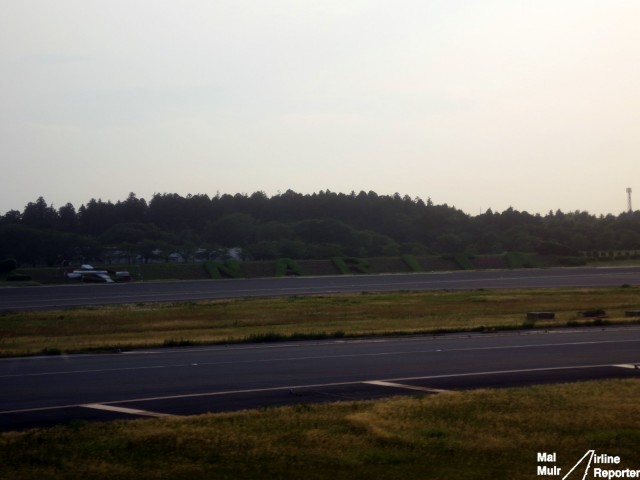
It is not hard to tell just where you are, and if the sign doesn’t help, perhaps all the ANA & JAL aircraft around are a clue – Photo: Mal Muir | AirlineReporter.com
This is the continuation of a multi-part series covering my trip from Seattle to San Jose to Narita to Hong Kong and back as a ANA Ambassador. My flight was provided by ANA, but all opinions are my own. First read: ANA Ambassador Report 1: San Jose to Tokyo on the 787 Dreamliner.
A majority of flights to Asia from the westcoast, require a connection through an intermediary stop. Cathay Pacific has their hub in Hong Kong, Asiana and Korean have their hubs at Incheon. However, four airlines have their hubs in Tokyo: Delta, United, All Nippon Airways (ANA) and Japan Airlines (JAL).
This means that on a good day you can see a variety of aircraft and flights in and out of Narita International Airport (NRT). This makes the airport not only nice for the general traveler, but also for the AvGeek. I recently was able to take a closer look at transitioning in NRT while on my way to Hong Kong (HKG).
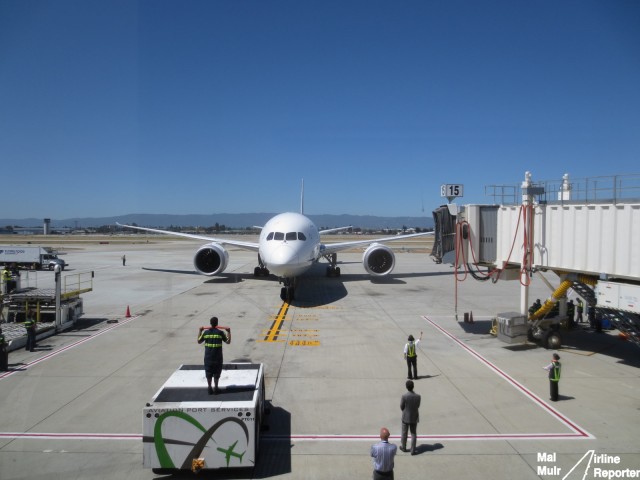
The All Nippon Airways 787 Dreamliner Arrives back to San Jose Airport, ready to turn around for it’s flight back to Tokyo Narita – Photo: Mal Muir | AirlineReporter.com
This is the first in a multi-part series covering my trip from Seattle to San Jose to Narita to Hong Kong and back home as a ANA Ambassador. Note that my flight was provided by ANA, but all opinions are my own.
Departing from San Jose’s Norman Y Mineta Airport (SJC) could not have been more of a breeze. The weather was perfect, the check in area was quiet and security lines were nonexistent. It was a great way to start off my flight to Tokyo.
I was about to embark on All Nippon Airway’s (ANA), first 787 service out of the US since the infamous grounding . With boarding passes in hand, I was escorted to the gate by a member of the airport staff where we could photograph the arrival of the 787 Dreamliner.
After being joined by other media, we grabbed the arrival photos from the sterile corridor and then headed up to the lounge. The ’œClub at SJC’ is the new lounge that opened the day prior to the first service that ANA operated out of San Jose back in January. Unless you’re a business class guest (or Star Alliance Gold member) flying the one and only ANA flight out of SJC, the lounge will cost you an entry fee.
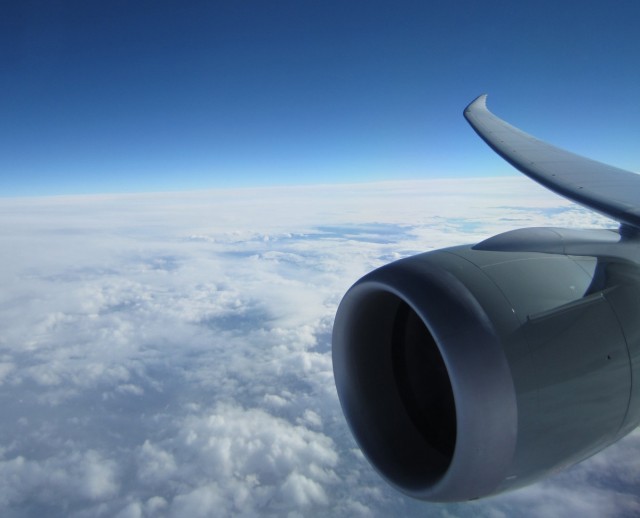
The wing is astounding on the Boeing 787 Dreamliner. Photo: Malcolm Muir / AirlineReporter.com.
This is the final installment of a multi-part (PART 1 & PART 2) series was written by AirlineReporter.com correspondent Mal Muir on the Qatar Airways Boeing 787 Dreamliner delivery flight (note: Qatar Airways covered Malcolm’s trip to Doha to cover this story).
With the flight now well and truly underway, most of the passengers on board were sleeping, but I remained not able to sleep. This is not because of the 787 Dreamliner; I have a history of not being able to sleep on aircraft. This meant that I had plenty of time to explore the plane, get in some work, have a chance to relax, and still fit in a few movies.
Having the on board Wi-Fi meant that I was able handle all of those emails I had been avoiding. For those on a business trip, Wi-Fi allows you to stay connected to the office and remain productive (maybe that is not always a good thing). It also works out if you are a Twitter fanatic, so you do not feel disconnected from the Twitterverse.
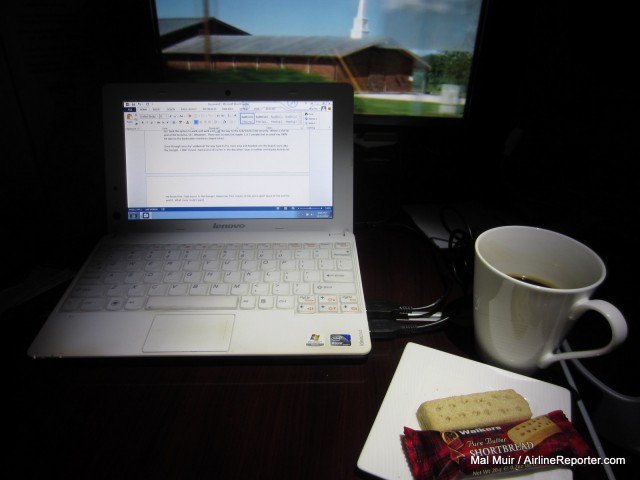
What is better than being on a Boeing 787 Dreamliner? Being able to tell all your friends via the internet while flying at 30,000 feet. Photo: Malcolm Muir / AirlineReporter.com.
The extra-large windows were a godsend for those in the back during the flight. As we passed over Iceland they managed to get 2.5 hours of uninterrupted viewing of the Northern Lights. Unfortunately those of us up the front totally missed out since our windows were blacked out — I guess there are some benefits to flying economy.
When there was no outside light-show, I was able to check out the economy section during flight and tested out the Recaro seats. The Seats in the Economy Cabin were comfortable enough and would be fine for the medium length flights this Aircraft was fitted out for. With a leather cover on the neck rest, they felt luxurious while not being to hard or uncomfortable, as some leather cushions can be. I was also able to see the Social Media Command center set up as Qatar Airways was live tweeting their way across the globe.
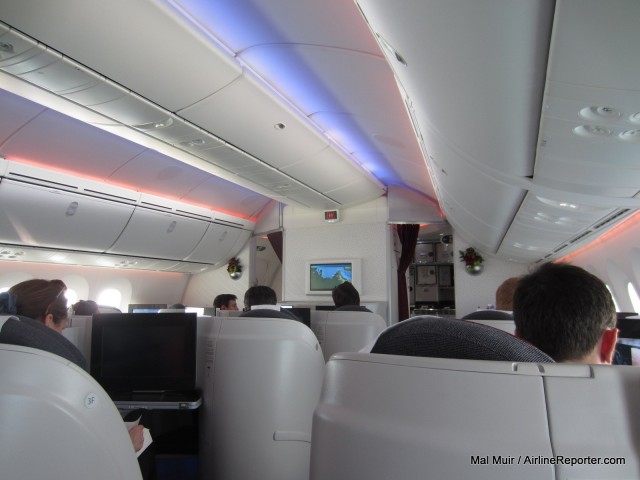
The business cabin is prepared to start our way into Doha after a long journey. Photo: Mal Muri / AirlineReporter.com.
Unfortunately I wasn’t able to get any face time with the CEO, Akbar Al Baker, who was on board our flight. He was able to take advantage of the comfy seats and slept most of his way to Doha. I have it say it was surreal seeing the CEO of the airline in the Business Class PJ’s.
As we crossed over Eastern Europe, heading towards Turkey and the Middle East, passengers started to wake up and the cabin crew started serving breakfast with freshly made espresso (not that I hadn’t stopped eating — I had a midnight snack as well).
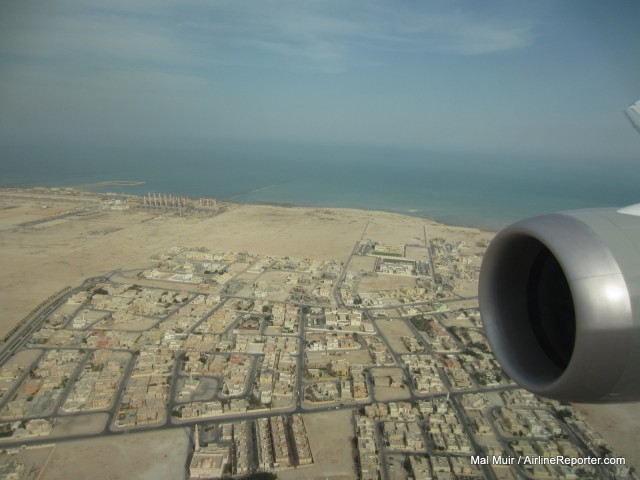
Flying over Doha — about to land. Photo: Mal Muir / AirlineReporter.com.
As we approached Doha, we prepared for our arrival. The flight was long, but many of us did not want the flight to end. Even though I got no sleep on the 14 hour flight, I felt oddly ready to go. It could have been the adrenaline and excitement, but could also have to do with the Dreamliner itself. The 787 has a new climate control system on board where the cabin is pressurized and humidified at a lower altitude, which allows you to feel more refreshed. I wasn’t fully able to appreciate the difference until my Boeing 777 flight home a few days later (I will be sharing a 787 vs 777 story later).
We started our descent into Doha and as the airport came into view, it was truly a sight to behold. The blue waters of the Gulf, the yellow of the desert and just the small buildings and everything dotting the landscape. It was unlike anything I had ever seen before — and I have seen quite a bit.
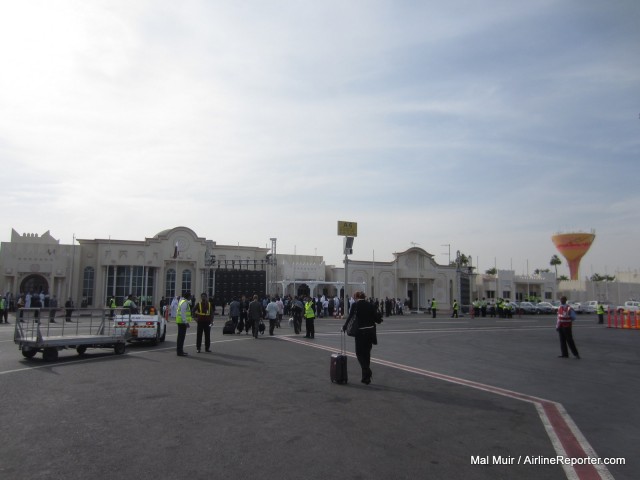
Welcome to Doha. Image: Malcolm Muir / AirlineReporter.com.
After we touched down at Doha International Airport we taxied towards the ministerial lounge (currently used for heads of state when they depart and the Amir of Qatar). The taxi ways and other areas of the airport were just full of Qatar Airways and other airport staff, all wanting to welcome the Dreamliner.
Even though we did not get a traditional water cannon salute on arrival, this was still a big deal with over 2 busloads of media waiting for us on arrival with big TV screens to show the aircraft landing. As we disembarked and headed into the lounge area another press conference was underway by the CEO of the airline and the local representative for Boeing.
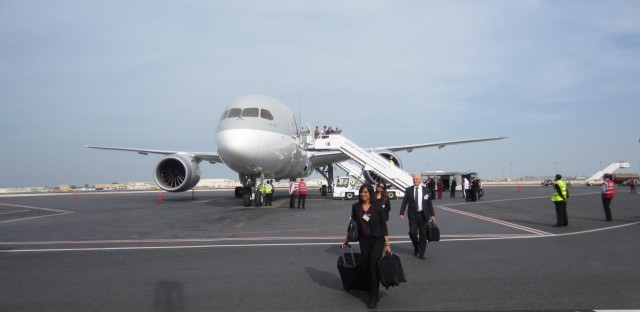
It was a long, yet fun journey to get to Doha. Photo: Mal Muir / AirlineReporter.com.
Once the press conference was over, the local media were given access to the aircraft while those of us on the flight, were bussed over to the arrivals terminal so that we could clear immigration, customs and get over to our hotel for the evening to get some sleep (at least for those of us who can not sleep well on planes).
The 787 flight was a once in a lifetime experience. It showcased that you can merge cutting edge technologies both in the on board experience and in the hardware of the aircraft itself to bring a truly magnificent piece of aircraft into the sky. I had a few days to explore Doha before my flight home and I look forward to share the rest of my adventures with Qatar Airways in the upcoming weeks.
ALL THE QATAR AIRWAYS BOEING 787 DELIVERY PHOTOS:

 |
This story written by…Malcolm Muir, Lead Correspondent. Mal is an Australian Avgeek now living and working in Seattle. With a passion for aircraft photography, traveling and the fun that combining the two can bring. Insights into the aviation world with a bit of a perspective thanks to working in the travel industry.
@BigMalX | BigMal’s World | Photos |
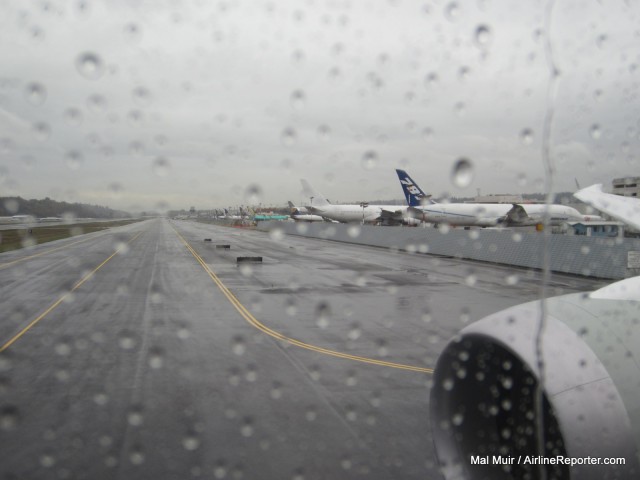
It was not surprising that it was raining in Seattle as Qatar’s first 787 left Boeing Field. Photo by Mal Muir / AirlineReporter.com.
This multi-part (PART 1) series was written by AirlineReporter.com correspondent Mal Muir (note: Qatar Airways covered Malcolm’s trip to Doha to cover this story).
It’s grey outside, rain clouds threaten and there is a chill in the air (substantial for this Aussie implant to the USA) to warrant a scarf. I don my properly-themed Boeing scarf and head out into the morning air of this Seattle fall day. The weather cannot dampen my mood, nothing (apart from an inherent lack of coffee) can do that right now. I am about to hitch a ride on a 787 Dreamliner.
Tuesday the 13th of November 2012 is the day that Qatar Airways made their first 787 delivery flight. As we departed downtown for Boeing Field (BFI) we were all excited and restless. Our departure was delayed and this was making some people antsy, but our arrival time to Doha, Qatar had not changed.
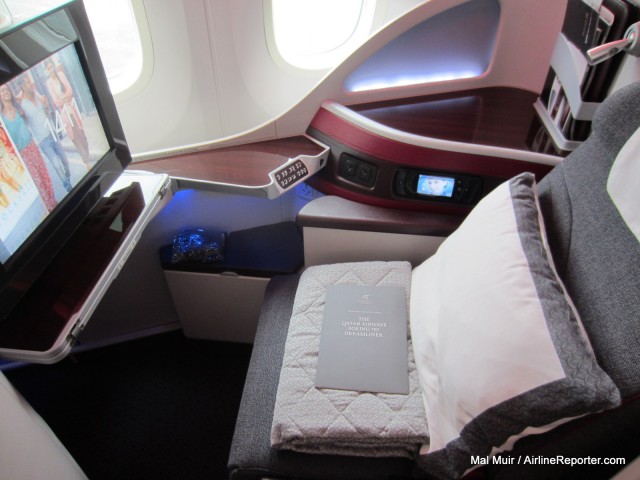
Qatar Airways Boeing 787 Business Class seat. Photo: Mal Muir / AirlineReporter.com.
The flight ,QR3787, was to happen on-board A7-BCB, the first Qatar Airways 787. We were set to fly the approximately 7500 miles direct to Doha with only about 90 people on-board, including a mixture of Qatar Airways staff, Boeing staff, contractors (such as Thales, Recaro, OnAir and BE Aerospace) and invited guests & media (the category I fell under).
I was lucky enough to be assigned a Business Class seat (4K), but with only 22 premium seats up front, the remainder of the passengers had to sit in economy. Do not feel too bad for them, each got a full row to themselves and received Business Class level of service.
Although most non-737 delivery flights happen at Paine Field (in Everett), our flight was departing from Boeing Field, just south of downtown Seattle. I assume this was done since LOT Polish Airlines was taking delivery of their first Dreamliner at Paine on the same day.
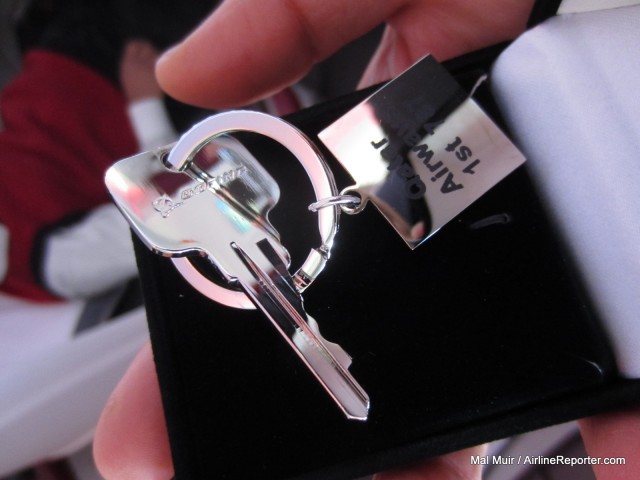
A souvenir Qatar Airways Boeing 787 key for invited guests. Image: Mal Muir / AirlineReporter.com.
Before boarding, there was no big TSA-style security; although laptops and liquids could stay in, my belt and shoes could not. It was a quick and visually appealing drive along the Boeing Field ramp past rows of 737s before arriving at the 787. As we approached the aircraft, the excitement got the better of me and I was stunned that I was about to set foot on-board my first 787 flight (although I had previously been on United’s 787). If my excitement wasn’t high enough already, I was handed a souvenir key by Boeing staff at the bottom of the stairs, marking the delivery.
On-board was a mix of people taking photos, mingling with the staff and the crew and just starting to relax into what would be a fantastic journey. I had a quick chat with the Captain in charge of the flight, and learned that the day would also mark the line check of the first Qatar Airways 787 pilot. Qatar and Boeing pilots would take turns at the controls of the plane and I was interested in knowing where the crew was planning to rest between shifts.
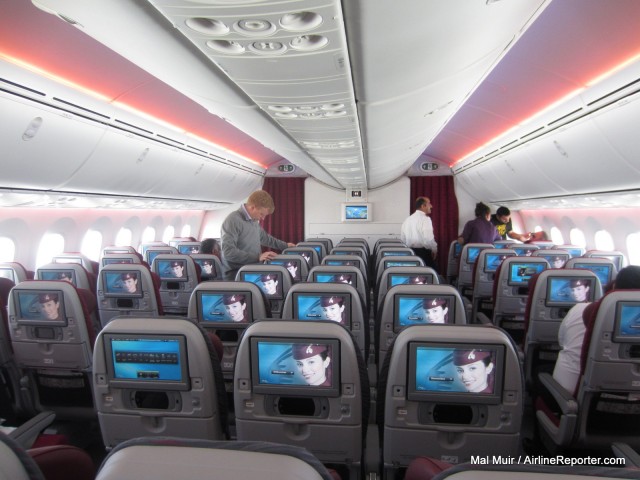
Even in a 9-abreast configuration, economy did not look too shabby. Although, I was happy I had a business class seat. Image: Mal Muri / AirlineReporter.com.
Qatar designed this variant of their 787s with mid haul flights in mind (flights of 5-7 hours) so there is no crew rest facilities on-board, which have been seen on other Dreamliners. We were looking at a 12-14 hour flight ahead of us (ultra long haul), so how would they rest? The Qatar Captain revealed that a portion of the Economy Cabin was set aside for the cabin crew and 2 business class seats had been set aside for the flight crew.
Soon enough, the door was closed, an announcement was made and we all had to take our seats. As we were about to push back from our parking bay, a United 787 pulled in right next to us as almost to wish us well on our journey.
We taxied to the end of 13R, the two GENx engines spooled up and we were on our way. The engines did not seem to have the force of the GE90, but they were much quieter and were able to easily get us off the ground. Being airborne in the 787 for the first time was surreal. Seeing just how far that composite wing flexes once airborne was a little bit crazy, at one point it seemed it was higher than the aircraft itself. A true work of engineering art.
We climbed out towards the south before turning to track north and on our polar route towards the middle east. Soon the seat belt sign came off and we were free to roam the cabin.
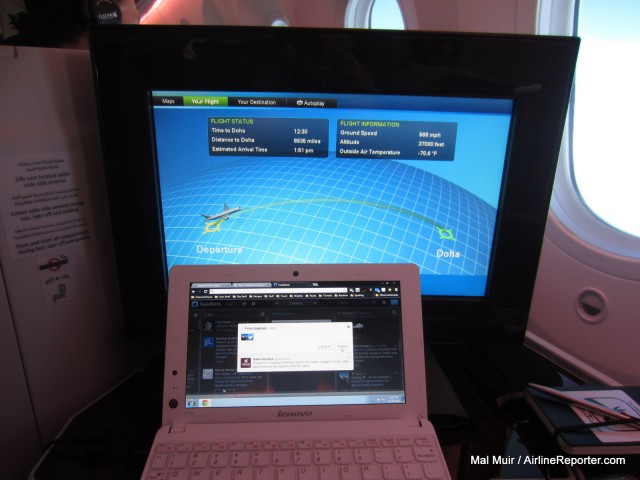
YAY! The first 787 Dreamliner delivered with Wi-Fi ready to go. Image: Mal Muir / AirlineReporter.com.
Qatar selected OnAir to provide on-board Wifi and GSM services on their new 787s. Although a little slow to start (as I’m sure it was due to everyone hammering it at the same time to connect and be the first to say ’œI’m on-board’) the service was pretty consistent. One down fall is you couldn’t have more than one device connected to a single account at any time. This was probably more of an issue during a media event than it would be for a normally scheduled flight.
Without even realizing it, we were almost 90 minutes into the flight before the lunch service began, but to be honest, I had not even noticed. This seemed to be the whole feeling on the flight; time moved quickly.
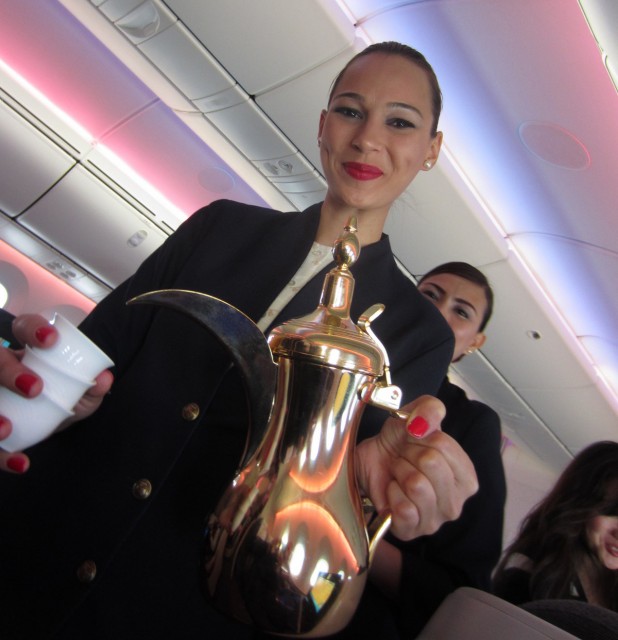
A successful airline is much more than just a seat and food. It is about the people. Image: Mal Muir / AirlineReporter.com.
The CEO of Qatar Airways, Akbar Al Baker, previously stated that, ’œBusiness Class is the new First Class.’ This was definitely true with amenities provided from Salvatore Ferragamo including slippers, an amenity kit (in a stylish pouch) and even pajamas. This 5 star service (Qatar Airways continues to win many different awards) continued with the menu for lunch being a 5 course, individually plated affair of a mixture of traditional Arabic meals with a mixture of Western and Indian options.
The meal time was also the first chance I got to fully play with the new state of the art Thales IFE system. Touted as cutting edge, this system had what was described as two screens at each seat. The main screen in Business Class is a large 15’ LCD with the second screen being the remote itself. The system is android based so the remote is a touch panel and allows you to be able to navigate menus and edit playlists, all without interrupting the current selection that you have playing on the main screen.
It even had the ability to display a full moving map display on the remote while the main screen was playing a movie. That’s how I knew we were currently somewhere over Canada as I was watching The Dark Knight Rises while enjoying the 5 course meal’¦ that’s the way to fly right?
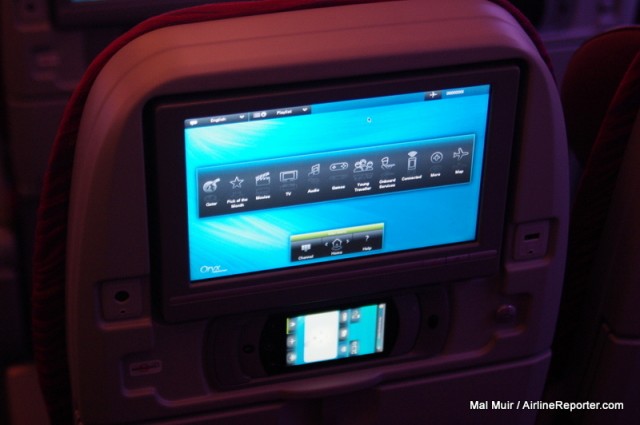
Two screens are better than one right? IFE in economy. Image: Mal Muir / AirlineReporter.com.
After the filling meal, most people started changing their seat into sleep mode and the crew blacked out all the cabin windows. The cabin became very quiet now as it seemed to be a little bit more quieter compared to a 777 or 747, though not upper-deck on an A380 quiet. I was hoping to catch some sleep, but with all the distractions and excitement, I knew that might have been difficult.
Continue reading with PART 3 of this story…
 |
This story written by…Malcolm Muir, Lead Correspondent. Mal is an Australian Avgeek now living and working in Seattle. With a passion for aircraft photography, traveling and the fun that combining the two can bring. Insights into the aviation world with a bit of a perspective thanks to working in the travel industry.
@BigMalX | BigMal’s World | Photos |
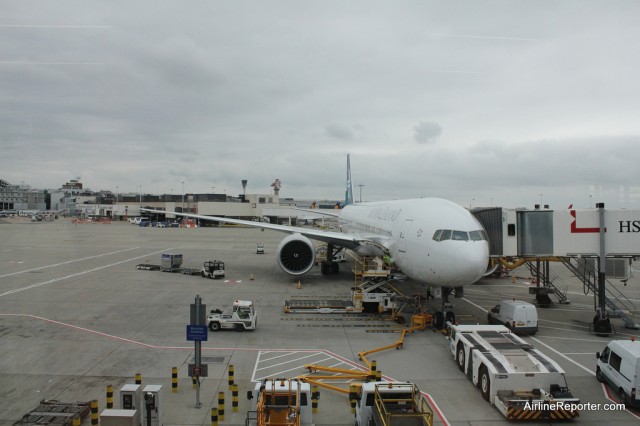
A glorious grey sky in London.
AIR NEW ZEALAND BUSINESS PREMIERE REVIEW BASICS
Airline: Air New Zealand
Aircraft: Boeing 777-300ER
Departed: London’s Heathrow Airport (LHR)
Arrived: Los Angeles International Airport (LAX)
Stops: Non-stop flight
Class: Business Premiere
Seat: 1J (right center aisle)
Length: 10.5 hours
Cheers: The fact that I slept through most of the flight is probably one of the best reviews possible.
Jeers: I want to see out the window.
Bottom Line: It is confusing to figure out if this really is a Business product or First Class.
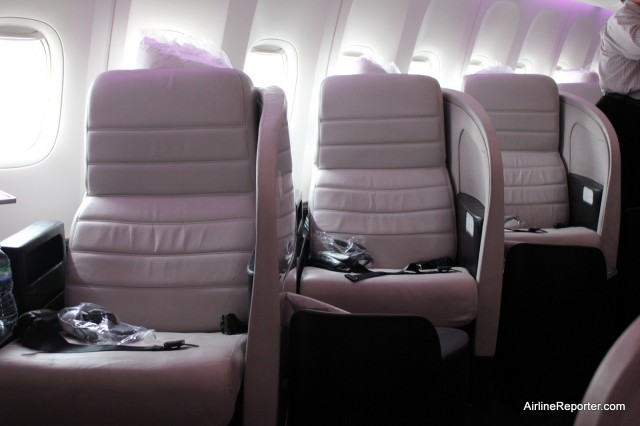
The “window” seats face away from the window, which isn’t so great for AvGeeks, but does provide more privacy.
Earlier, I posted my experience flying Air New Zealand’s Premium Economy from LAX to LHR. I was impressed with the product and was looking forward to how their Business Premium would compare (note: the airline covered my airfare and I paid the taxes). There are many similarities between Premium Economy and Business Premiere, but there are also key differences. Both can check-in at a priority line, get free alcoholic beverages and priority boarding. The extra money spent to upgrade will get you lounge access, premium wines on board, additional food options, a larger screen (10.6″ vs 12.1″) and a fold flat bed.
This was actually my second flight on Air New Zealand’s Business Premier, but only my first “real” one. My previous experience was taking the airline’s first Boeing 777-300ER from Paine Field down to Los Angeles, which was only a 2.5hr media flight. I was happy to try out the product in a “real world” situation and I had a good 10.5 hours to do it. Are the extra features and product worth the ticket premium (or miles)? I think it depends on how you want your flight experience to go.
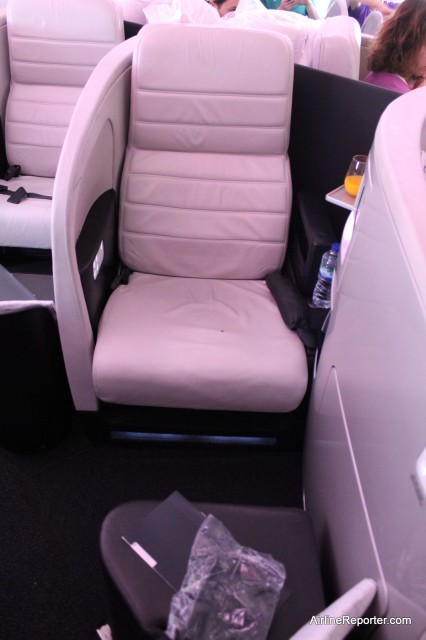
Each seat has quite a bit of privacy for its occupants.
When first walking into the cabin, it is obvious that the Business Premier class is an upgrade. Instead of a 2-2-2 layout in Premium Economy, Business gives you a 1-2-1 layout, but really it feels more like a 1-1-1-1 set up since you are so isolated.
If you are traveling with someone else, you won’t be able to easily interact while sitting in your seat, but have no worries. The seats easily allow two people to sit and talk at the same seat. This isolation also gives every passenger access to the aisle, which means you don’t have to crawl over someone while they sleep to use the bathroom.
Each of the seats is angled to give passengers extra privacy. The biggest downside is not being able to look out the window with ease. Where the Premium Economy seat actually tilts you towards the window, the Business Premier tilts you away. Although I enjoy looking out the window, I much rather have the privacy and space, since the windows are shut after take off anyhow.
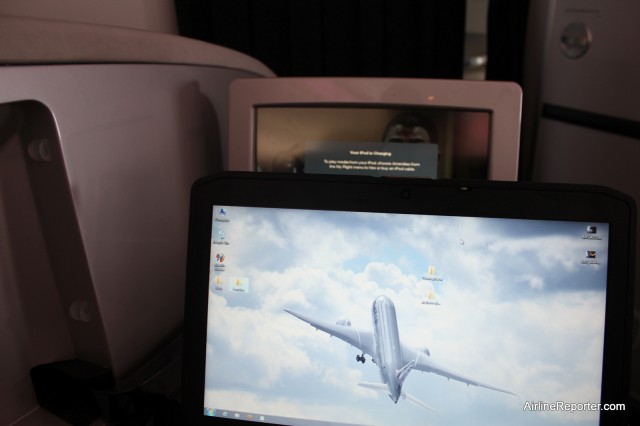
A larger laptop on the tray table gets in the way of the entertainment screen.
Now, the purpose of my flight was to check out the product, but I ran into a big problem… I fell asleep… for over six hours. That might be one of the best compliments when reviewing an airline’s product, right?
At first I was a bit confused about the seat. I kept hitting the recline button, but the seat would only recline so far. Turns out, it is one of those seats where you have to get up and fold down the bed. What a great Airline Reporter I am, not paying attention and thinking my seat was broken for a few minutes — oh well.
Yes, it takes a bit more of an effort to convert your seat into a bed, but I think it ends up being worth it. Once you have your seat folded forward, you are able to put a memory foam mattress on top. Then add the fluffy duvet and full size pillows and you are ready for a good night’s (or day’s) sleep. If you have any trouble or want some help, just hit the call button and the flight attendants will have no problem assisting.
I had plenty of room to roll around and get into multiple positions. If needed, I was given an eye mask to block out the light, but I didn’t need it. The soft glow of pink lighting was perfect for setting a sleeping mood.
This broke a record for me, since previously, the longest I have slept on a flight was four hours straight. I wasn’t even that jet-lagged, since I had a week in London and was more or less caught up on sleep. Oh well. That still gave me four hours to check out the product, food and drinks.
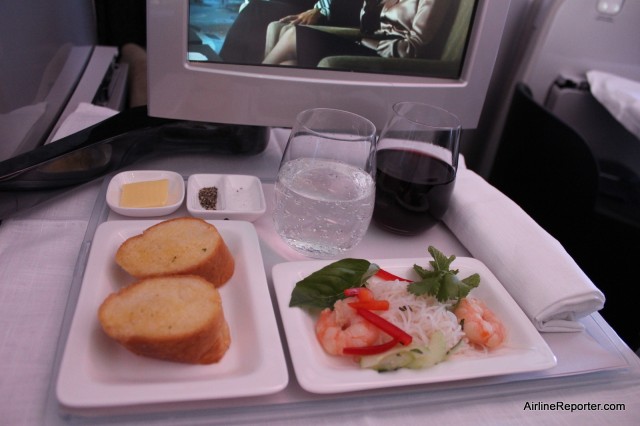
My dinner starter: prawns. I think I am watching Up in the Air here.
The meal service started shortly after take off (and before I went to sleep). I decided to watch the movie, Up in the Air (it seemed appropriate) and enjoy my meal. I started with coconut prawns with rice noodles and plum sugar dressing. Then I had a choice between lamb, salmon, chicken or eggplant. I decided to go with the lamb that was on cabbage and potato mash with field mushrooms and minted yoghurt. All amazing.
Then I finished it off with a little vanilla and chocolate ice cream. On my previously flight, dessert was served with the appetizer, which was a bit odd for me, but this time, it came after the meal with some dessert wine.
When I woke up, the cabin was still in sleep-mode and I was thirsty. I was able to fire up the ‘ol in-flight entertainment system and order from a nice selection of food and drinks. I decided on some Diet Coke and sparkling water. The cool part is I was able to customize how my drink was served. Why, yes, I will take ice in both and a lemon wedge in my water. Less than a minute later, my drinks were delivered.
Near the end of the flight, we were served a second meal, which was quite a bit lighter. I had a choice of smoothie, fruit, wraps or scones.
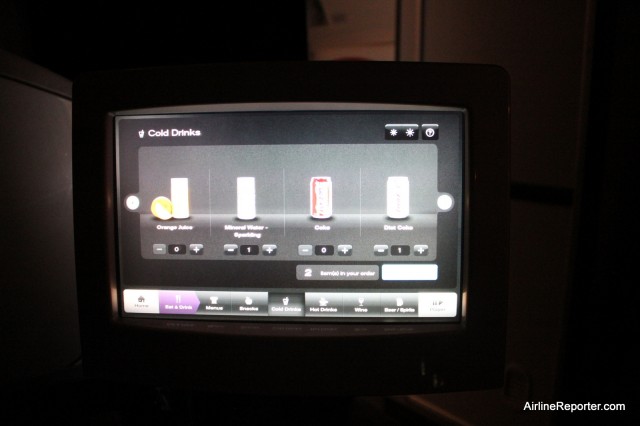
Ordering additional drinks or food during non-meal service is quick and easy.
When I received my ticket to fly, the Business Premiere section was filled. I was hoping to get a window seat, but there were none left. Even after checking multiple times before the flight and again at check-in, there were still no other seats. I would have preferred not sitting in the first row, since many times, when my feet were up, the curtain would hit them anytime anyone passed.
So, is upgrading to Business Premiere worth the additional money over Premium Economy? Well, that depends. If you need to sleep well, there is no question that it is worth more. However, if your game plan is to stay up the entire flight and maybe talk to the person next to you, then maybe Premium Economy will do what you need.
But the fact that on average, Business Premiere seats cost $4000-5000 and Premium Economy cost $2000-$2500, that is not a bad deal. Especially when you compare these products to other international seats that cost much more. If you are a person who has the ability to either pay or use miles to upgrade to the front of the plane, it will be hard to find an upgrade per dollar that gives you this good of a deal.
ADDITIONAL PHOTOS OF AIR NEW ZEALAND’S BUSINESS CLASS:
[nggallery id=17]






















